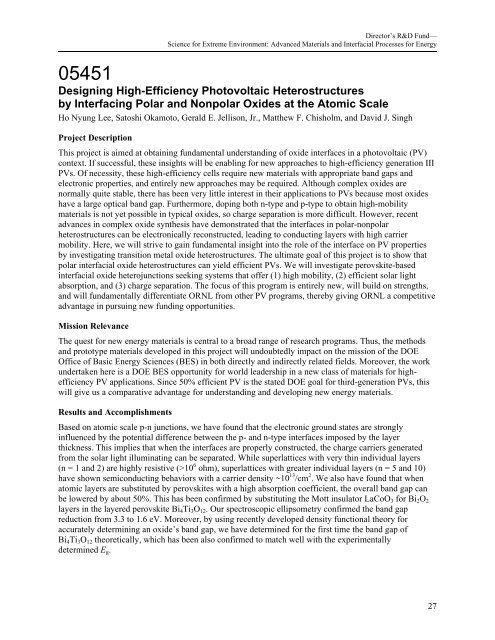FY2010 - Oak Ridge National Laboratory
FY2010 - Oak Ridge National Laboratory
FY2010 - Oak Ridge National Laboratory
Create successful ePaper yourself
Turn your PDF publications into a flip-book with our unique Google optimized e-Paper software.
Director’s R&D Fund—<br />
Science for Extreme Environment: Advanced Materials and Interfacial Processes for Energy<br />
05451<br />
Designing High-Efficiency Photovoltaic Heterostructures<br />
by Interfacing Polar and Nonpolar Oxides at the Atomic Scale<br />
Ho Nyung Lee, Satoshi Okamoto, Gerald E. Jellison, Jr., Matthew F. Chisholm, and David J. Singh<br />
Project Description<br />
This project is aimed at obtaining fundamental understanding of oxide interfaces in a photovoltaic (PV)<br />
context. If successful, these insights will be enabling for new approaches to high-efficiency generation III<br />
PVs. Of necessity, these high-efficiency cells require new materials with appropriate band gaps and<br />
electronic properties, and entirely new approaches may be required. Although complex oxides are<br />
normally quite stable, there has been very little interest in their applications to PVs because most oxides<br />
have a large optical band gap. Furthermore, doping both n-type and p-type to obtain high-mobility<br />
materials is not yet possible in typical oxides, so charge separation is more difficult. However, recent<br />
advances in complex oxide synthesis have demonstrated that the interfaces in polar-nonpolar<br />
heterostructures can be electronically reconstructed, leading to conducting layers with high carrier<br />
mobility. Here, we will strive to gain fundamental insight into the role of the interface on PV properties<br />
by investigating transition metal oxide heterostructures. The ultimate goal of this project is to show that<br />
polar interfacial oxide heterostructures can yield efficient PVs. We will investigate perovskite-based<br />
interfacial oxide heterojunctions seeking systems that offer (1) high mobility, (2) efficient solar light<br />
absorption, and (3) charge separation. The focus of this program is entirely new, will build on strengths,<br />
and will fundamentally differentiate ORNL from other PV programs, thereby giving ORNL a competitive<br />
advantage in pursuing new funding opportunities.<br />
Mission Relevance<br />
The quest for new energy materials is central to a broad range of research programs. Thus, the methods<br />
and prototype materials developed in this project will undoubtedly impact on the mission of the DOE<br />
Office of Basic Energy Sciences (BES) in both directly and indirectly related fields. Moreover, the work<br />
undertaken here is a DOE BES opportunity for world leadership in a new class of materials for highefficiency<br />
PV applications. Since 50% efficient PV is the stated DOE goal for third-generation PVs, this<br />
will give us a comparative advantage for understanding and developing new energy materials.<br />
Results and Accomplishments<br />
Based on atomic scale p-n junctions, we have found that the electronic ground states are strongly<br />
influenced by the potential difference between the p- and n-type interfaces imposed by the layer<br />
thickness. This implies that when the interfaces are properly constructed, the charge carriers generated<br />
from the solar light illuminating can be separated. While superlattices with very thin individual layers<br />
(n = 1 and 2) are highly resistive (>10 6 ohm), superlattices with greater individual layers (n = 5 and 10)<br />
have shown semiconducting behaviors with a carrier density ~10 13 /cm 2 . We also have found that when<br />
atomic layers are substituted by perovskites with a high absorption coefficient, the overall band gap can<br />
be lowered by about 50%. This has been confirmed by substituting the Mott insulator LaCoO 3 for Bi 2 O 2<br />
layers in the layered perovskite Bi 4 Ti 3 O 12 . Our spectroscopic ellipsometry confirmed the band gap<br />
reduction from 3.3 to 1.6 eV. Moreover, by using recently developed density functional theory for<br />
accurately determining an oxide’s band gap, we have determined for the first time the band gap of<br />
Bi 4 Ti 3 O 12 theoretically, which has been also confirmed to match well with the experimentally<br />
determined E g .<br />
27
















